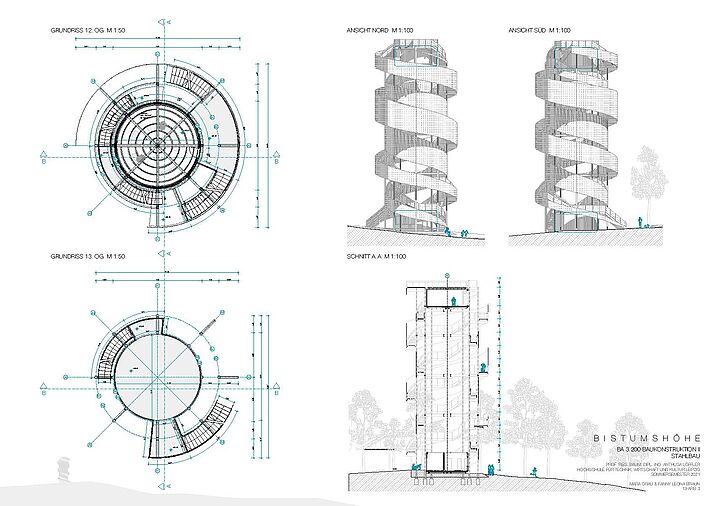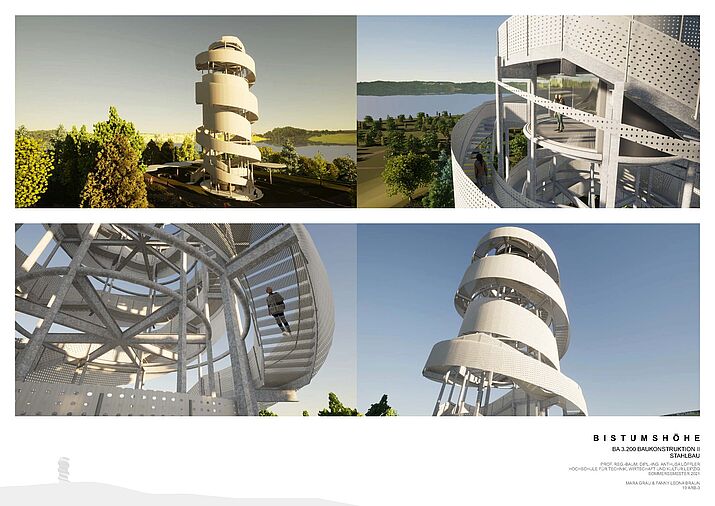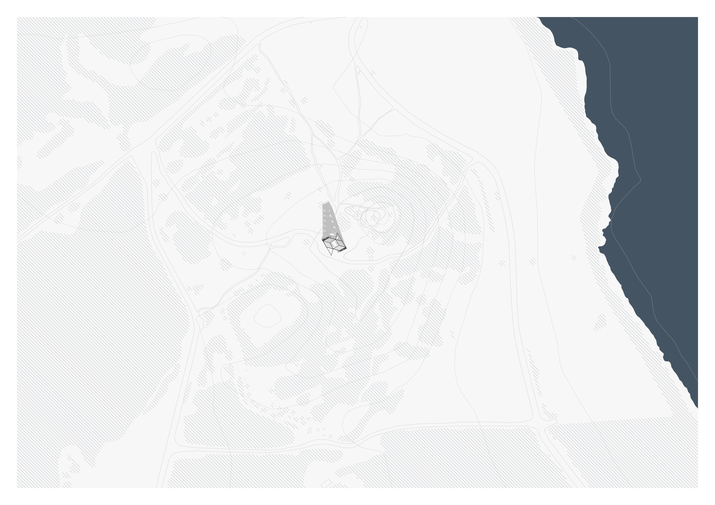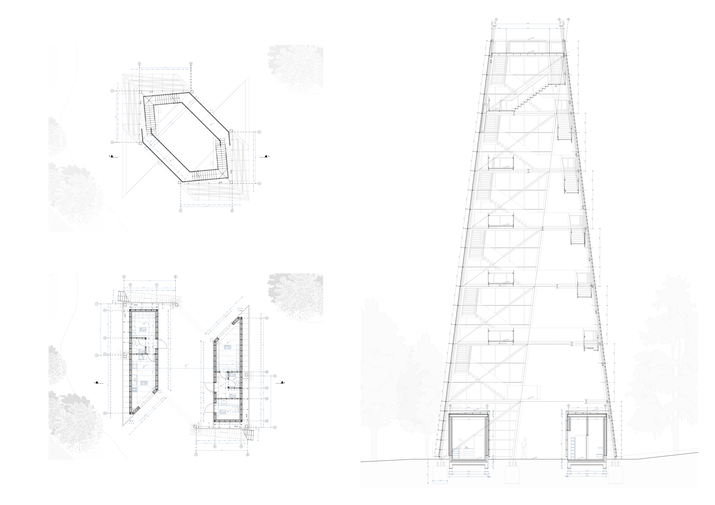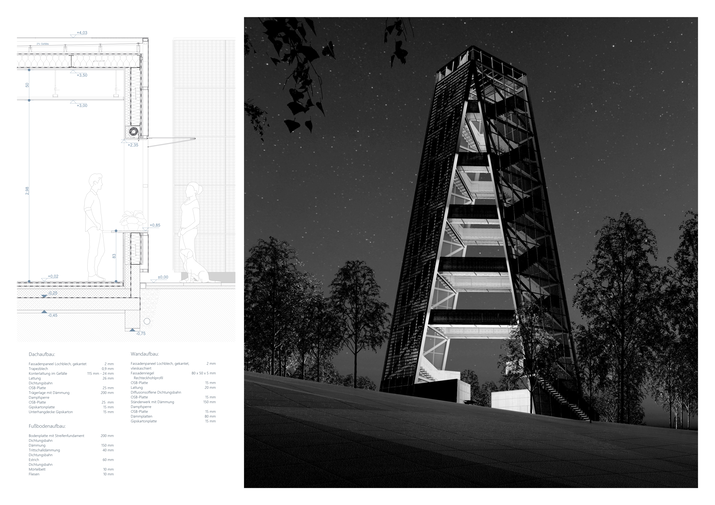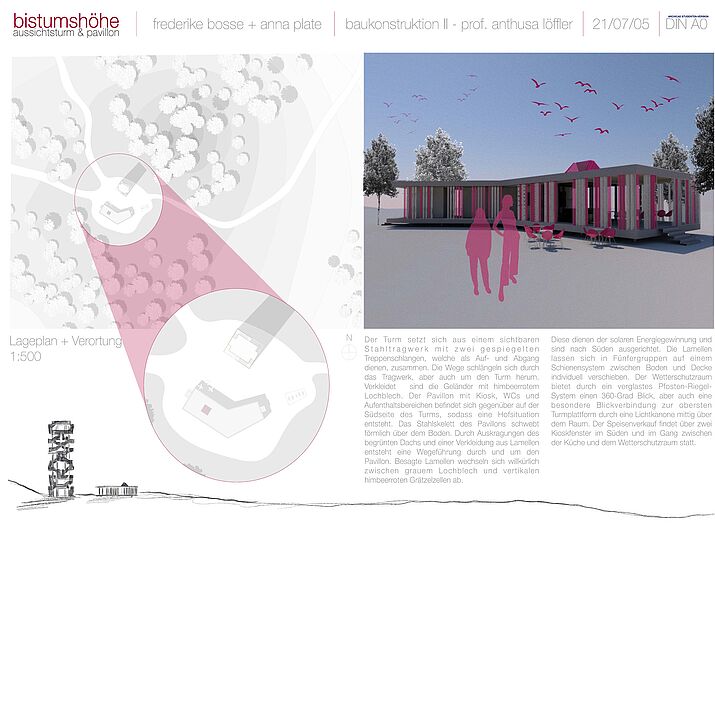Mara Grau & Fanny Leona Braun
The tower developed from a cylindrical centre that is wrapped around two organic spirals. They symbolise the wind swirling around a body. These spirals form a staircase and a staircase exit. The central centre provides space for the kiosk, the toilets and a store on the ground floor. At the top, a room has been integrated into the structure, which has been designed as a weather shelter with a view of Lake Cospuden and the town beyond. Above this is a viewing platform. The changing height of the railings creates different lines of sight. Visitors to the tower can deliberately direct their field of vision to the sky or look out into the distance. The perforated sheeting also creates great shadow effects when the sun shines.
Markus Barthel & Simon Ruff
Just 30 years ago, the earth in the south of Leipzig was dug up to supply the region with lignite. In the meantime, the open-cast mining pits have been filled in and are now used for recreation. If you follow the paths through the newly created forests, there is no sign of the former industry. But if you raise your eyes above the trees, you can sense the extent to which the surrounding landscape has been destroyed. To give people this view and remind them of how carelessly nature was treated in the past, a viewing tower now stands between Zwenkau and Lake Cospuden like an artefact in the landscape. A sculpture that seems to change its shape from every angle, allowing views but also concealing them. From the circular path around Lake Cospuden, one is only drawn to the top of the tower by small, inconspicuous paths and is naturally led to the high point of the Bistumshöhe by sales areas that twist towards the volume of the tower.
Fredrerike Bosse & Anna Plate
In the south-west of Lake Cospuden in Leipzig is the Bistumshöhe, on which a viewing tower with a kiosk, weather shelter and covered outdoor area was to be built.
We decided to erect two independent structures that complement each other and blend into the landscape thanks to their identical materiality and ingenious alignment in terms of pathways and sightlines
.
Like a walk-in sculpture, the tower is made up of a visible steel structure with two mirrored staircases that serve as an ascent and descent. The paths wind their way through the anthracite-coloured supporting structure, but also around the tower, creating vantage points at various heights.
The banisters of the staircases are clad in raspberry-red perforated sheeting, making it visible from afar.
The pavilion with kiosk, toilets and recreation areas is located opposite on the south side of the tower, creating a courtyard situation. The steel skeleton of the pavilion literally floats above the ground and can be reached via two steel folding staircases. Projections of the green roof and a cladding of louvres create a pathway through and around the pavilion. These slats alternate randomly between grey perforated sheeting and vertical raspberry-red Grätzel cells.
These are used to generate solar energy and are therefore orientated towards the south.
They can be moved individually in groups of five on a rail system between the floor and ceiling. The weather protection room offers a 360-degree view of the landscape through a glazed mullion and transom system, as well as a special visual connection to the topmost tower platform through a light cannon in the centre above the room. Food is sold via two kiosk windows to the south and in the passageway between the kitchen and the
weather shelter.
Alina Krügler & Michelle Liebsch
AUS BRICK
The new observation tower with adjoining kiosk and lounge is located on the elevation between Lake Cospuden and the Belantis amusement park in Leipzig, south of the city, called Bistumshöhe.
Stahlbau is known for its expressive constructions, which often also serve as a façade design. Our aim was to allow the structural level to simply fade into the background, which is why a translucent brick shell surrounds our tower. This light shell allows the solid steel construction to shine through and creates an exciting contrast between orthogonal statics and gentle façade design.
Brick was chosen for the materiality of the shell, which ironically is better known for its solidity in masonry construction. However, thanks to FLEXBRICK's ingenious façade system, it is possible to suspend the bricks and develop individual patterns.
The envelope becomes more translucent on each side of the tower towards the centre, emphasising the 35-metre height and at the same time allowing visitors to see in all directions. At night in particular, the tower has an impressive effect thanks to its backlit façade, which is also visible from a distance. This means that the tower is not only exciting to look at from close up, but is also a real eye-catcher from a distance.
The kiosk is spatially separated from the tower so as not to distract from the tower's effect. The kiosk references the tower through the staggered heights of the individual rooms. A brick façade was also used here to create a harmonious overall appearance.


